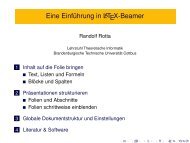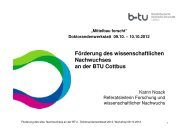Multilevel Graph Clustering with Density-Based Quality Measures
Multilevel Graph Clustering with Density-Based Quality Measures
Multilevel Graph Clustering with Density-Based Quality Measures
You also want an ePaper? Increase the reach of your titles
YUMPU automatically turns print PDFs into web optimized ePapers that Google loves.
4.3 Effectiveness of the Merge SelectorsAs another extreme the times measured on the graph Lederberg main are listedin Table 4.4b. While the mean degree of this graph is around 10 it contains somehigh-degree vertices <strong>with</strong> an extreme vertex having 1103 incident edges. Here thematching algorithm reached the maximal number of coarsening levels (200) regardlessof the reduction factor.Concerning grouping vs. matching, the table and plot of mean modularities showsthat greedy grouping always performed slightly better than matching. Moreover thebehavior of the matching algorithm on the graph Lederberg main confirmed that itis unreliable. Hence greedy grouping should be used as coarsening method.4.2.3 Reduction FactorIn order to find the best reduction factor the mean modularity Table 4.3 of theprevious subsection is reused. In addition Figure 4.2b shows a plot of the meanmodularities of G-sgrd and the runtime on the graph DIC28 main against the reductionfactors.Without refinement the reduction factor has no real influence on greedy grouping(G-none). Just a small influence is visible <strong>with</strong> greedy matching (M-none). Maybebecause <strong>with</strong> more coarsening levels it select less bad cluster pairs. Combined <strong>with</strong>greedy refinement smaller reduction factors improve the clusterings. However halvingthe reduction factor from 10% to 5% doubles the runtime and the number ofcoarsening levels while the difference in mean modularity is very small. Therefore asa trade off between quality and runtime the reduction factor 10% is a good choice.4.3 Effectiveness of the Merge SelectorsThe merge selector is used by the coarsening methods to rank cluster pairs in theselection process. This section experimentally compares the developed merge selectorsto find the best. First the best parameters for the random walk distance andreachability selectors are searched. Then these are compared <strong>with</strong> the other mergeselectors.4.3.1 Random Walk DistanceThe random walk distance selector has one parameter RW length controlling thelength of random walks. Here the lengths 1–5 are studied. The clusterings arecompared using greedy grouping <strong>with</strong> refinement, named RWdist-sgrd, and <strong>with</strong>out,named RWdist-none. All other parameters are set to their default values.Table 4.5 summarizes the mean modularities gained <strong>with</strong> the 10 configurations onthe reduced graph set. The columns contain the length of random walks and the rowscontain the two basic algorithm combinations. The best mean modularity of eachrow is highlighted to make good lengths visible. The same values are also plotted inFigure 4.3a. As reference the dashed lines mark the mean modularity produced bythe standard weight density selector <strong>with</strong> refinement (WD-sgrd) and <strong>with</strong>out (WDnone).Appendix B.1 contains a detailed table of the clusterings produced on eachgraph.67






